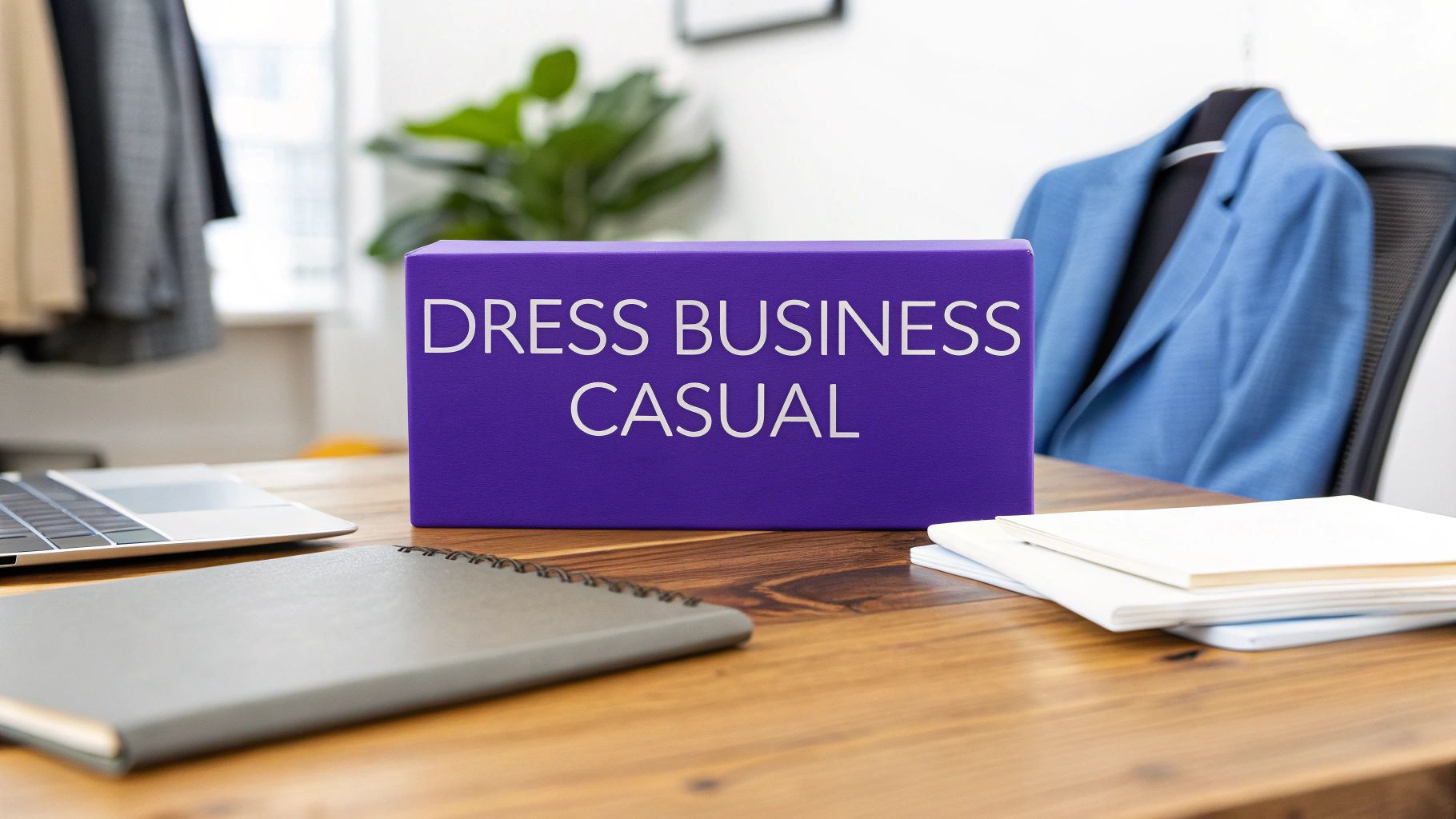
How to Dress Business Casual: Master Modern Workplace Style
By Emma Johnson - 8/6/2025
Decoding Business Casual in Today's Workplace
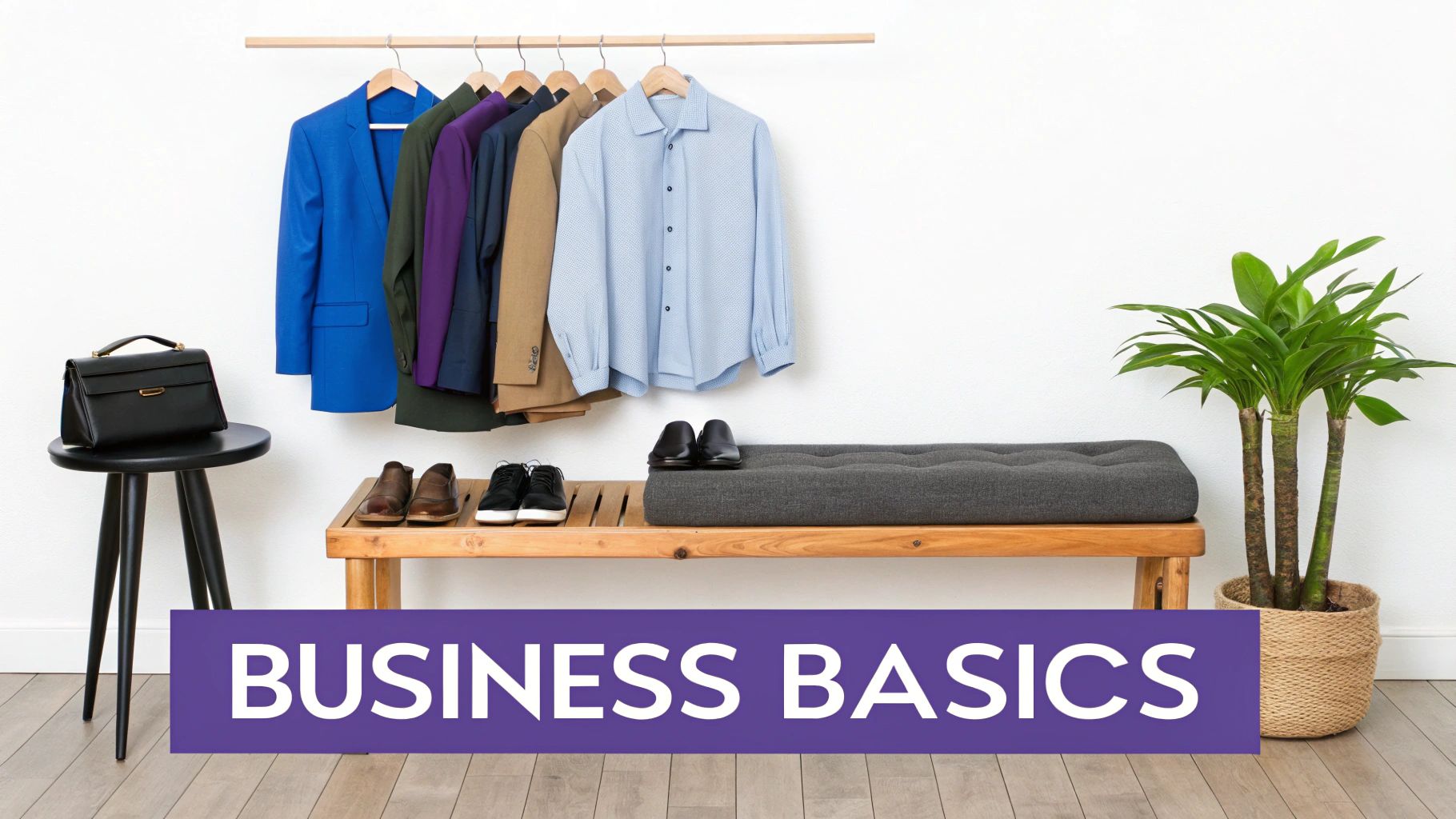
The modern workplace has undergone a significant shift in dress codes, leaving many professionals unsure about what constitutes appropriate business casual attire. This change is driven by several factors, including evolving cultural norms and the increasing prevalence of remote work. Understanding these influences is essential for projecting a professional image while maintaining comfort. "Business casual" is no longer a rigid definition, but rather a fluid concept that varies between industries and even individual companies.
One of the most impactful factors in this shift is the growing acceptance of casual clothing in professional environments. Recent years have witnessed a notable trend toward more relaxed dress codes. By 2022, approximately 70% of employers favored casual dress, while only 29% maintained a business casual preference. This change is largely attributed to the COVID-19 pandemic, which normalized remote work and, consequently, more relaxed clothing standards. Traditional business attire has declined significantly, with only about 3% of U.S. workers regularly wearing suits, down from 7% in 2019. You can explore further insights into this trend here. This shift signifies a broader cultural movement towards comfort and flexibility in professional settings.
Industry Nuances in Business Casual
While the overall trend leans towards casual, certain sectors, like finance and law, generally retain a more traditional approach to business casual. Visualize this as a spectrum with casual attire on one end and formal attire on the other. Business casual occupies the middle ground, but its precise position varies depending on the specific industry.
- Tech: This industry often leans towards the casual side, prioritizing functionality and comfort.
- Finance: Typically adheres to a more formal interpretation of business casual, emphasizing polished and structured outfits.
- Creative Industries: May offer greater latitude for individual expression, often focusing on style and current trends.
Core Principles of Business Casual
Despite these industry-specific variations, certain fundamental principles of business casual remain consistent. These core elements provide a valuable framework for understanding the often-unspoken rules of workplace attire. Neatness and appropriateness are always key considerations.
Fit: Well-fitting clothing is essential, regardless of the specific garments. Tailored pants or a well-fitted blazer are generally preferred over baggy or overly tight clothing.
Fabric: Opt for fabrics that convey a professional appearance. Materials like cotton, linen, wool, or silk are suitable choices, while overly casual fabrics like jersey or distressed denim should generally be avoided.
Footwear: Closed-toe shoes are typically the standard, though some workplaces may permit sandals or loafers. Ensure your shoes are clean and well-maintained.
Accessories: Accessories can enhance your overall look, but it's best to keep them understated and professional. A simple watch, necklace, or scarf can add a touch of personal style without being distracting.
By understanding these core principles and the nuances within different industries, you can confidently navigate the world of business casual. Building a wardrobe that balances professionalism and personal style will project confidence and competence, creating a positive impression in any professional setting.
Building a Men's Business Casual Wardrobe That Works
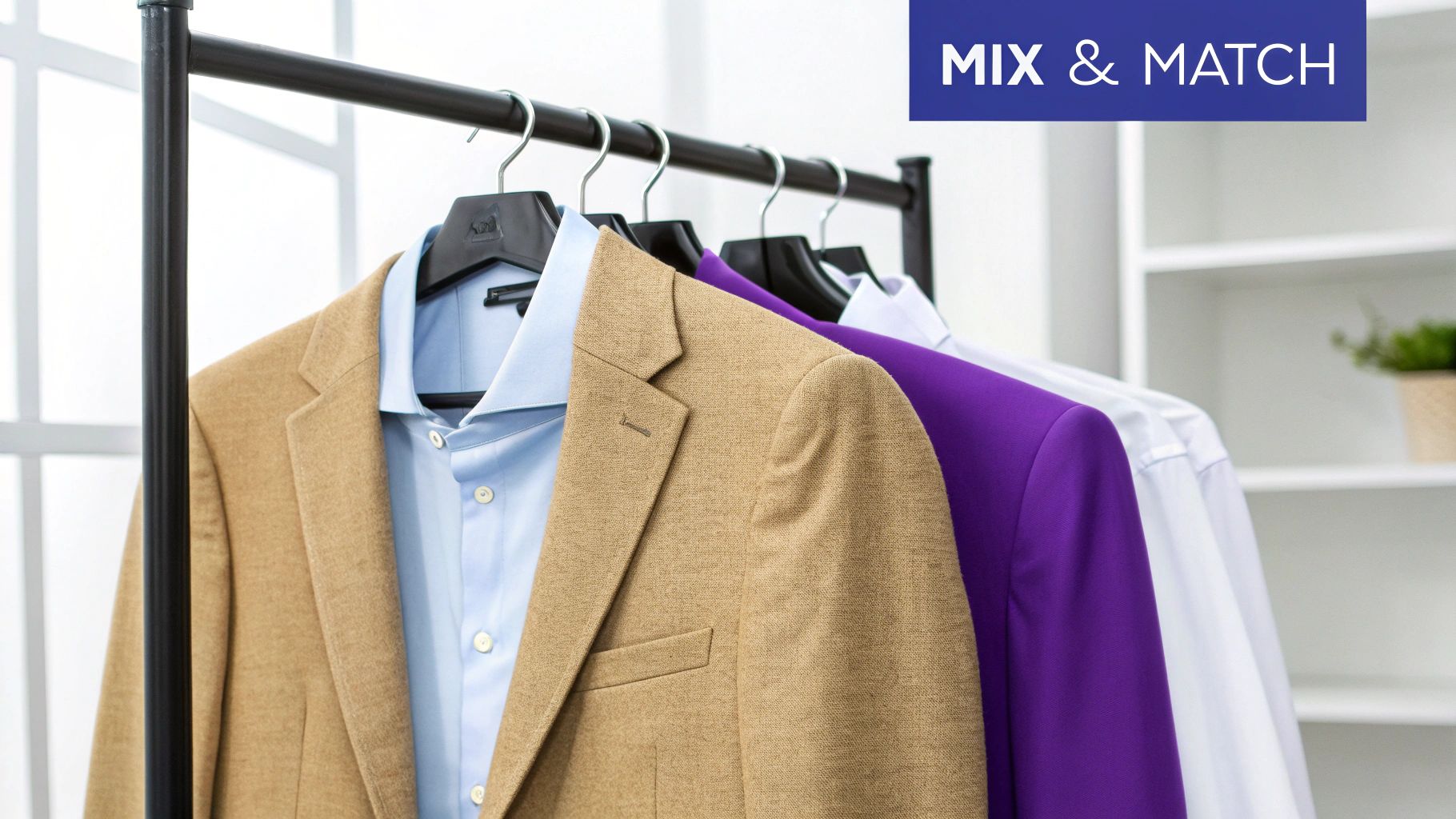
Creating a versatile business casual wardrobe isn't about filling your closet to the brim. It's about making smart choices and selecting the right pieces. This strategic approach allows you to build a functional and stylish wardrobe without breaking the bank. Think of it as building a house: a solid foundation is essential before adding the decorative touches.
Essential Pieces for a Strong Foundation
Certain key items are the cornerstones of any successful men's business casual wardrobe. These foundational pieces serve as the building blocks for your everyday outfits.
Well-Fitted Trousers: Chinos, dress pants, or even dark-wash jeans (depending on your office environment) are essential. Aim for two to three pairs in neutral colors like navy, gray, or khaki.
Versatile Shirts: Button-down shirts in a range of colors and patterns, along with polos and knit sweaters, offer options for layering and varying levels of formality.
A Statement Blazer: A well-fitting blazer can instantly elevate any outfit. Navy or gray are classic and versatile choices.
Quality Shoes: Leather loafers, oxfords, or brogues are crucial for completing the look. Keeping them clean and well-maintained is a must.
To help visualize the essentials, take a look at the table below:
Introduction to table: The following table outlines the core components of a men's business casual wardrobe, differentiating between must-have essentials and optional additions. This comparison helps prioritize investments and build a functional wardrobe efficiently.
| Essential Item | Purpose | Recommended Quantity | Investment Priority |
|---|---|---|---|
| Well-Fitted Trousers (Chinos, Dress Pants, Dark Wash Jeans) | Foundation of most outfits; adaptable to various occasions | 2-3 pairs | High |
| Versatile Shirts (Button-downs, Polos, Knit Sweaters) | Layering and style options; adaptable formality | 5-7 | High |
| Statement Blazer | Elevates outfits; adds polish | 1-2 | Medium |
| Quality Leather Shoes (Loafers, Oxfords, Brogues) | Completes the look; conveys professionalism | 2-3 pairs | High |
| Accessories (Belts, Watches, Pocket Squares) | Adds personality and refinement | Varies | Low |
| Outerwear (Lightweight Jacket, Trench Coat) | Protection from elements; adds style | 1-2 | Medium |
Conclusion of table: As the table illustrates, focusing on high-priority essentials first ensures a functional base. Optional items can then be added to personalize and expand your wardrobe over time.
Investing in Quality Over Quantity
Building a successful business casual look hinges on quality over quantity. Look for garments made from durable fabrics like cotton, linen, or wool. Pay attention to construction details like reinforced seams and well-made buttons. These are indicators of quality and ensure your clothes will last longer and look better over time. This also translates to long-term savings, as you won't need to constantly replace worn-out items.
Maximizing Your Wardrobe Through Careful Curation
Effective wardrobe curation is about choosing pieces that work together in multiple combinations. A single blazer, for instance, can be paired with various shirts and trousers, creating a range of outfits suitable for different situations. This strategy maximizes your wardrobe’s potential without requiring an overflowing closet. By focusing on versatile, high-quality pieces, you can create a business casual wardrobe that is both stylish and functional, ensuring you're always ready to make a strong impression.
Crafting a Women's Business Casual Collection That Delivers
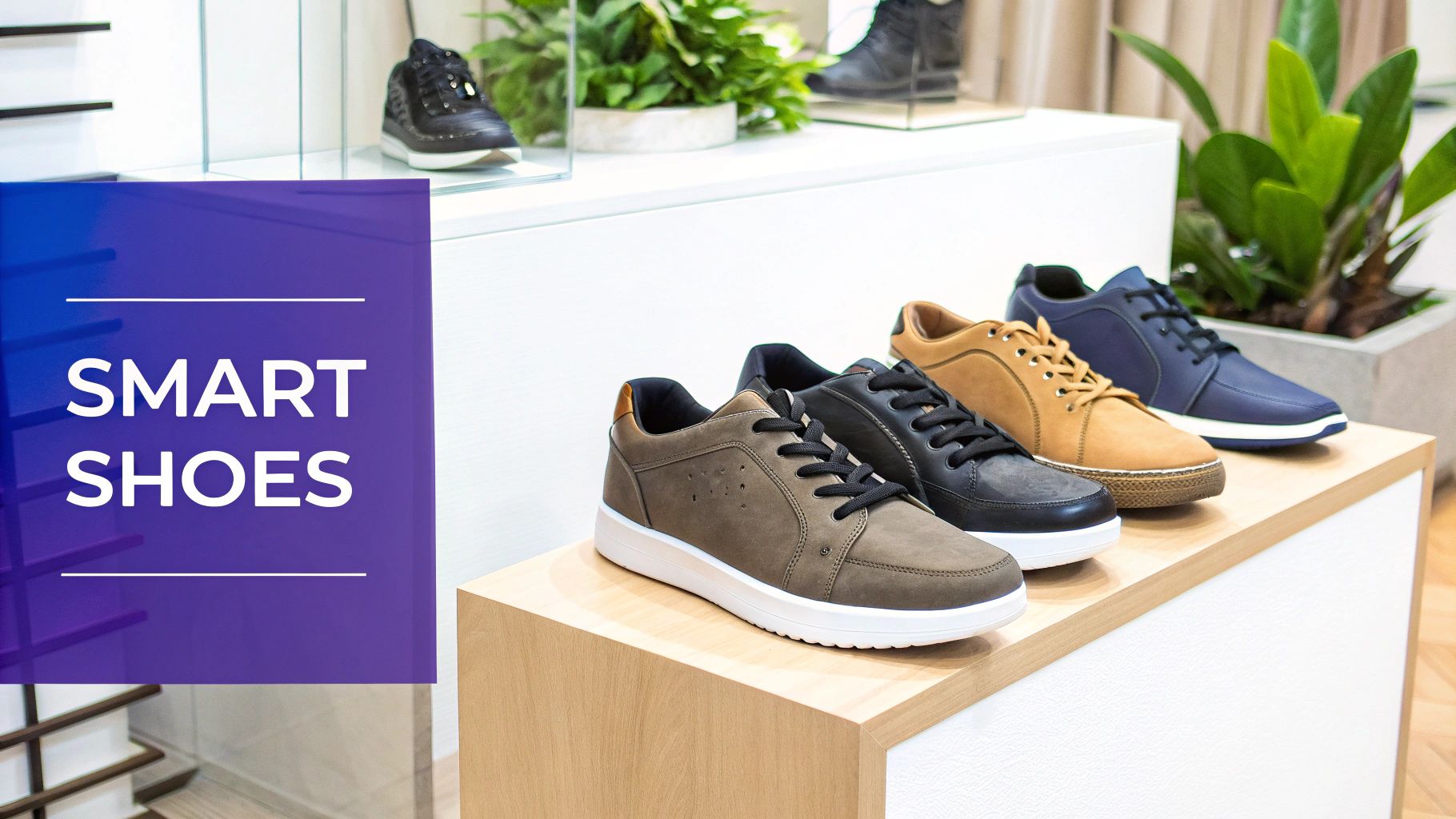
Women's business casual attire offers a broader spectrum of choices than men's, presenting both opportunities and challenges. Successfully building a women's business casual wardrobe hinges on striking the right balance between professionalism and personal expression. This involves selecting pieces that are versatile, adaptable, and reflective of individual style while still aligning with workplace dress codes. A thoughtful approach to wardrobe curation not only simplifies your morning routine but also cultivates confidence, ensuring you always look and feel your best.
Foundational Pieces For A Versatile Wardrobe
Similar to menswear, a few key items form the core of a functional and fashionable women's business casual wardrobe. These essential pieces can be mixed and matched to create a variety of outfits suitable for diverse occasions.
Adaptable Blazers: A well-fitting blazer in a neutral color like black, navy, or gray can instantly elevate an outfit. It can easily dress up a simple blouse and jeans combination or complement a dress for a more formal appearance.
Strategic Dress Selections: Dresses provide a complete, single-piece solution for business casual dressing. Select styles appropriate for the workplace, such as sheath, A-line, or wrap dresses. Avoid overly short or revealing designs.
Classic Blouses and Tops: A collection of blouses in various colors and styles, from crisp button-downs to flowing silk tops, offers options for diverse looks. Include both neutral and more vibrant colors to expand styling possibilities.
Well-Fitting Bottoms: Trousers, skirts, and even dark-wash jeans (depending on the specific workplace) are essential. A mix of styles and colors, from tailored trousers to flowy skirts, provides choices for different settings.
To help you visualize these essential pieces and their versatility, we've compiled a helpful table:
Introduction to the table: The table below, "Women's Business Casual Essentials," outlines key garments, styling options, and their suitability across seasons and professional environments.
| Garment Type | Styling Options | Seasonal Versatility | Professional Appropriateness |
|---|---|---|---|
| Blazer | Pair with blouses, dresses, trousers, or skirts | Year-round with layering adjustments | High, suitable for meetings, presentations, and client interactions |
| Sheath Dress | Can be styled with blazers, cardigans, or worn alone | Spring, Summer, Fall (with layering) | High, appropriate for most office settings |
| A-Line Dress | Can be styled with belts, cardigans, or worn alone | Spring, Summer, Fall (with layering) | Medium-High, suitable for most office settings |
| Wrap Dress | Can be styled with belts or worn alone | Spring, Summer, Fall (with layering) | Medium, consider the specific print and fabric |
| Blouse (Button-down) | Pair with trousers, skirts, or under blazers | Year-round with layering adjustments | High, classic and professional |
| Blouse (Silk) | Pair with trousers, skirts, or under blazers | Spring, Summer, Fall (with layering) | Medium-High, depending on the style and cut |
| Tailored Trousers | Pair with blouses, sweaters, or blazers | Year-round | High, suitable for all professional settings |
| Skirt (Pencil) | Pair with blouses or sweaters | Year-round | High, a professional staple |
| Skirt (A-line) | Pair with blouses or sweaters | Spring, Summer, Fall | Medium-High, depending on the length and fabric |
| Dark Wash Jeans | Pair with blouses, sweaters, or blazers | Fall, Winter, Spring | Varies depending on workplace, generally suitable for casual Fridays or less formal offices |
Key takeaway from the table: By strategically selecting these foundational pieces and understanding their styling options, you can create a versatile and professional wardrobe suitable for a variety of situations.
The interpretation of business casual varies based on factors such as demographics and industry norms. A Gallup poll showed that 51% of women prefer business casual, while 30% opt for more casual street clothes, highlighting the changing nature of workplace dress codes. You might also find this resource helpful: How to master your wardrobe through understanding skin undertones.
Evaluating Garment Appropriateness
Beyond the specific garments, understanding the nuances of silhouette, proportion, and styling is critical for a polished business casual look. This means paying attention to fit and how pieces work together for a cohesive outfit.
Silhouettes: Select silhouettes that flatter your body type and project a professional image. Tailored pieces typically create a more polished appearance than oversized or baggy clothing.
Proportions: Balancing proportions is key. If you’re wearing a loose-fitting top, pair it with more fitted bottoms, and vice versa. This creates a harmonious and professional look.
Styling Approaches: The way you style an outfit significantly impacts its appropriateness. Rolling up sleeves or adding a statement necklace can add personality while maintaining professionalism. By considering these elements, you can create business casual outfits that are both stylish and appropriate for your workplace.
Foolproof Business Casual Outfit Formulas Worth Mastering
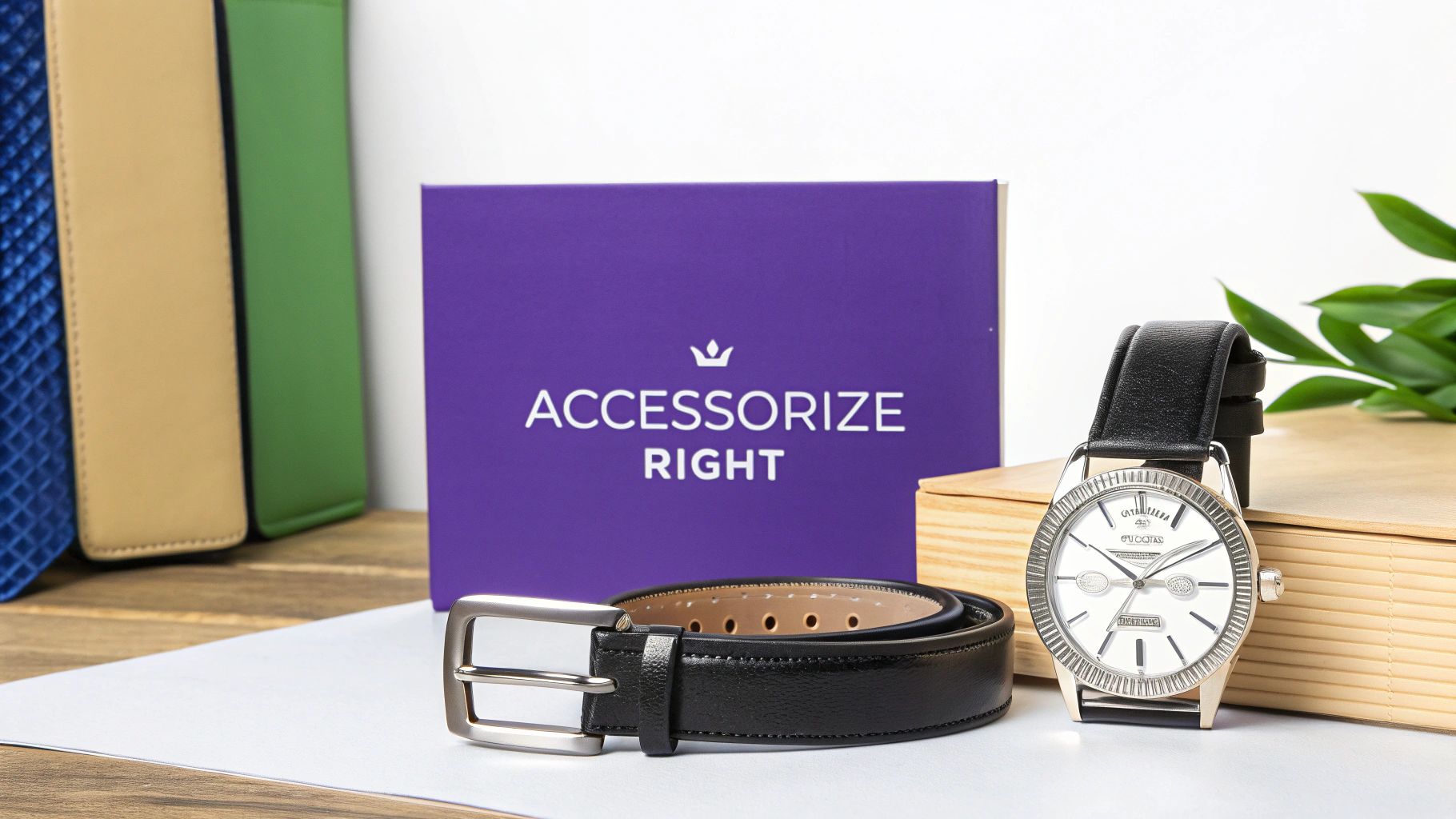
Successfully navigating business casual attire often relies more on how clothes work together than on individual items. This means understanding the art of combining pieces for a cohesive and polished look. To simplify this, we've compiled foolproof outfit formulas inspired by professional stylists. These formulas take the guesswork out of dressing for the office and provide a foundation you can personalize.
Formula 1: The Elevated Basic
This formula elevates everyday staples for a professional setting, perfect for those who prefer minimalism.
- Base: Start with well-fitting chinos or dress pants in a neutral color.
- Top: Add a crisp button-down shirt or a stylish blouse. Consider a pop of color or subtle pattern.
- Layer (Optional): A lightweight sweater or blazer adds warmth and sophistication.
- Shoes: Complete the look with loafers, oxfords, or sleek flats.
This formula is adaptable. Swapping the button-down for a polo shirt creates a more relaxed feel, while a blazer adds instant formality.
Formula 2: The Statement Piece
This formula revolves around a single statement item that anchors the outfit. It's ideal for showcasing a unique piece.
- Statement Piece: Choose one focal point—a patterned skirt, brightly colored blazer, or striking jewelry.
- Supporting Pieces: Keep the rest of the outfit simple and neutral. A simple blouse, neutral sweater, or classic trousers work well.
- Accessories: Choose accessories that complement without competing with the statement piece.
- Shoes: Opt for shoes that complete the look subtly.
This formula allows personality and professionalism. A floral blouse with neutral slacks and understated jewelry works well for women. For men, a textured blazer with a simple button-down shirt and chinos is a strong choice.
Formula 3: The Layered Look
Perfect for transitional seasons or adding visual interest, this formula allows for easy adjustments throughout the day.
- Base: Begin with a simple top like a t-shirt or thin sweater.
- Layer 1: Add a cardigan, jacket, or blazer.
- Layer 2 (Optional): A scarf or statement necklace adds another dimension.
- Bottoms: Choose trousers, a skirt, or dark-wash jeans.
- Shoes: Select footwear appropriate for the overall look, like loafers, boots, or flats.
Layering helps adapt to temperature changes and adds complexity. You can start with a blazer and remove it later. However, layer thoughtfully to avoid a bulky appearance.
These formulas offer a starting point for mastering business casual. Experiment, adapt to your style, and create a wardrobe that’s both professional and reflects your individuality. This approach boosts confidence, no matter the occasion.
Mastering Hybrid Work Style: From Zoom to Boardroom
The rise of hybrid work presents unique challenges when it comes to business casual attire. Employees now need a wardrobe that effortlessly transitions from virtual meetings to in-person interactions, sometimes all in the same day. This necessitates a shift in how we approach business casual, with versatility becoming the essential element of a professional look. Mastering this balance is crucial for projecting an image of confidence and competence, regardless of the setting.
Strategies for Dressing Across Multiple Contexts
Today's professional requires a wardrobe that adapts to a range of environments. This adaptability is essential for navigating the dynamic nature of hybrid work. Think of your clothing options as tools, each with a specific yet flexible purpose.
High-Low Dressing: This strategy combines high-quality, timeless pieces with more relaxed items. A tailored blazer paired with a comfortable t-shirt and dark-wash jeans is a perfect example. This method maintains professionalism while also incorporating comfort and personal style.
Video-Call Ready: Solid colors and simple patterns are ideal for video calls. Avoid overly busy prints or distracting accessories that may not appear well on camera. A wrinkle-free and appropriately professional top is key, as it's the primary focus during virtual meetings.
Seamless Transitions: Select clothing that can easily be dressed up or down. A simple dress paired with a cardigan for a casual video call can be elevated for an in-person meeting with a blazer and statement jewelry. This adaptability minimizes the need for constant outfit changes throughout the day.
Current workplace dress codes are changing to reflect this new reality. Approximately 79% of employees adjust their clothing based on their work location, demonstrating a clear need for flexible dress codes. Find more detailed statistics here. This shift towards adaptable attire emphasizes the importance of a versatile wardrobe, balancing professionalism with individual comfort.
Adapting Your Wardrobe for the Hybrid Reality
Successful professionals in the hybrid work model are utilizing key strategies to optimize their wardrobes. These strategies focus on choosing pieces that work well in different environments and reduce the need for frequent outfit changes. Building a capsule wardrobe is a central part of this approach.
Versatile Pieces: Invest in clothing items that can be mixed and matched to create multiple outfits. A neutral blazer, for instance, can be worn with dress pants for a formal meeting and then paired with jeans for a more relaxed setting.
Minimizing Outfit Changes: Choose pieces that can transition from day to night without a complete wardrobe change. A simple shift dress can be styled with a cardigan during the day and then dressed up for an evening event with a statement necklace and heels.
Prioritizing Comfort: Incorporate comfortable yet professional attire into your wardrobe. This could mean choosing breathable fabrics like cotton or linen, or opting for shoes that provide both style and support. You can also learn more about maintaining a professional appearance with our guide on the importance of clean skin for accurate skincare results. This focus on comfort acknowledges the importance of feeling good while maintaining a polished image.
By incorporating these strategies, professionals can navigate the hybrid work landscape with style and confidence, ensuring a professional appearance in any setting.
Avoiding Business Casual Pitfalls That Undermine Credibility
Even with a solid grasp of business casual guidelines, missteps can easily happen. These seemingly small errors can subtly undermine your credibility at work. Through insights from hiring managers and workplace leaders, we've identified common pitfalls that can negatively impact professional perception. Avoiding these errors is key to projecting competence and confidence.
Recognizing The Subtleties of Business Casual
The line between appropriately casual and problematically informal can be surprisingly thin. Recognizing these subtle differences is essential for navigating the complexities of business casual. Think of it like a dimmer switch: you can adjust the level of formality depending on the situation.
Garments: While specific garment rules vary, certain items almost always fall outside business casual. Athletic wear, overly revealing clothing, and clothes with distracting graphics are typically inappropriate. Consider the message your clothes convey.
Styling Choices: Even appropriate garments can appear unprofessional if styled incorrectly. Wrinkled clothing, ill-fitting items, and excessive accessories can create a sloppy appearance. Attention to detail is crucial.
Outfit Combinations: Even individual business casual pieces can clash when combined incorrectly. For example, pairing a blazer with ripped jeans may send a conflicting message. A blazer is associated with more formal settings, while ripped jeans have a distinctly casual feel. Aim for a cohesive overall look.
Common Business Casual Missteps
Certain garments and styling choices frequently cause confusion. Identifying these common pitfalls will help you avoid unintentional style errors.
Too Casual: Items like graphic tees, athletic shoes, and shorts typically don't fit within business casual guidelines. While comfortable, these pieces project a relaxed image unsuited for most professional settings.
Too Formal: While dressing too casually can be a problem, being too formal can also be a misstep in a business casual environment. A full suit might feel out of place, while a blazer or sport coat achieves a professional look suitable for most situations.
Inappropriate Footwear: Footwear plays a significant role in your overall image. Flip-flops, worn-out sneakers, and excessively high heels are often inappropriate for business casual settings. Instead, choose clean, well-maintained shoes that complement your outfit professionally.
Ignoring Fit and Fabric: Regardless of the specific items, fit and fabric are crucial for a polished appearance. Ill-fitting clothing can appear sloppy, while inappropriate fabrics, such as sheer materials, can be unprofessional. Pay attention to these vital elements.
Evaluating Outfit Appropriateness
A few simple checks before heading to work can prevent business casual disasters. This proactive approach ensures your attire aligns with workplace expectations.
The Mirror Test: Take a moment to assess your outfit in a full-length mirror. Does it project the image you intend? Does it feel comfortable yet professional? Honest self-assessment is invaluable.
The "Would I Wear This to a Client Meeting?" Test: If you wouldn't feel confident wearing your outfit to a client meeting, it's probably not appropriate for a business casual environment. Consider this a reliable test for professionalism.
Seek Feedback: If you’re unsure about an outfit, ask a trusted colleague or friend for their honest opinion. An outside perspective can be helpful for identifying potential issues.
By understanding these subtle cues and proactively evaluating your outfits, you can avoid pitfalls that undermine credibility. This allows you to confidently navigate business casual and make style choices that enhance your professional image.
Elevating Your Business Casual Style Beyond the Basics
Mastering the fundamentals of business casual is a great starting point. Building a solid foundation with the basics allows you to experiment and refine your look. Taking your style to the next level involves incorporating strategic enhancements that transform a simple outfit into a statement. This isn't about adding elaborate pieces, but rather focusing on key elements that enhance your overall appearance.
Think of it like cooking: once you understand the basic recipe, you can experiment with seasonings and techniques to create a truly signature dish.
The Power of Thoughtful Accessories
Accessories are the secret weapon of a polished business casual look. They add personality and elevate even the simplest ensembles. This doesn't mean piling on jewelry or wearing flashy pieces. Instead, concentrate on a few carefully chosen accessories that complement your outfit and express your individual style.
- A quality watch
- A tasteful necklace
- A stylish scarf
- A sophisticated belt
These can make all the difference. For example, a simple silver necklace can add a touch of elegance to a plain blouse, while a colorful scarf can brighten a neutral-toned outfit.
Quality Fabric Selection: A Subtle Yet Significant Upgrade
The fabrics you choose play a crucial role in how your clothes look and feel. Opting for higher-quality fabrics instantly elevates your business casual attire. Consider the noticeable difference between a crisp cotton shirt and a flimsy one.
Quality fabrics drape better, hold their shape longer, and project an air of sophistication. This doesn't necessarily require spending a fortune. Seek out natural fibers like cotton, linen, wool, or silk, even in more affordable brands. These materials tend to appear more polished than synthetic fabrics. You might be interested in learning more about color palettes to further enhance your style: How to master your perfect color palette.
The Importance of Fit: Tailoring for Success
Regardless of how expensive or stylish your clothes are, if they don't fit well, they won't look good. A well-fitting outfit makes you look more polished and professional. This doesn't necessarily mean wearing tight clothing.
Instead, it's about ensuring your clothes are tailored to flatter your body shape. A blazer that nips in at the waist can create a more flattering silhouette than a boxy one. Properly hemmed trousers can make your legs look longer and leaner. Small adjustments, like hemming or taking in seams, can dramatically improve the overall look of your outfit.
Expressing Individuality While Maintaining Professionalism
Business casual allows for some personal expression. It's an opportunity to showcase your style while maintaining a professional image. This could involve adding a pop of color with a bright scarf or selecting unique jewelry. The goal is to strike a balance between personality and appropriateness. A bold print might be suitable in a creative industry but could be distracting in a more conservative setting.
Think of your outfit as a subtle yet effective way to communicate your personality. This will help you stand out while adhering to workplace expectations. By focusing on thoughtful accessorizing, quality fabrics, a good fit, and personalized touches, you can elevate your business casual style beyond the basics. This creates a distinctive and memorable impression that reflects your individuality and strengthens your professional image.
Ready to discover your most flattering colors? Visit AI Color Analysis and transform your wardrobe with personalized color insights!
Take your style to the next level with a professional analysis
You already know the theory. Now discover exactly which colors and styles enhance your personal image.
Loading...
Complete PDF report in less than 5 minutes
Your color season and personalized palette
Specific makeup and clothing recommendations
Based on professional color analysis
One-time investment:
One-time payment, no subscriptions. Instant access.